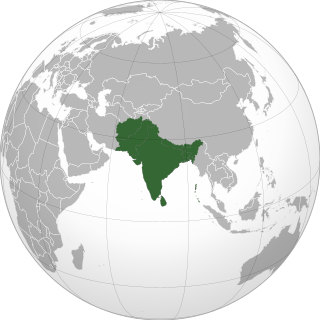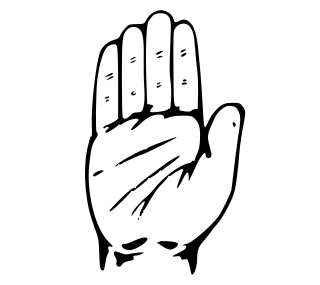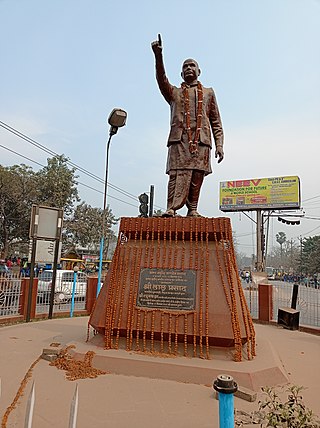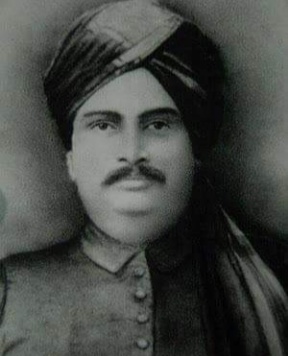Related Research Articles

Bihar is a state in Eastern India. It is the third largest state by population, the 12th largest by area, and the 15th largest by GDP in 2021. Bihar borders Uttar Pradesh to its west, Nepal to the north, the northern part of West Bengal to the east, and Jharkhand to the south. Bihar is split by the river Ganges, which flows from west to east. On 15 November 2000, southern Bihar was ceded to form the new state of Jharkhand. Only 11.27% of the population of Bihar lives in urban areas as per a 2020 report. Additionally, almost 58% of Biharis are below the age of 25, giving Bihar the highest proportion of young people of any Indian state. The official language is Hindi, which shares official status alongside that of Urdu. The main native languages are Maithili, Magahi and Bhojpuri. But there are several other languages being spoken at smaller levels.

Kurmi is traditionally a non-elite tiller caste in the lower Gangetic plain of India, especially southern regions of Awadh, eastern Uttar Pradesh and parts of Bihar and Jharkhand. The Kurmis came to be known for their exceptional work ethic, superior tillage and manuring, and gender-neutral culture, bringing praise from Mughal and British administrators alike.

The History of Bihar is one of the most varied in India. Bihar consists of three distinct regions, each has its own distinct history and culture. They are Magadha, Mithila and Bhojpur.Chirand, on the northern bank of the Ganga River, in Saran district, has an archaeological record dating from the Neolithic age. Regions of Bihar—such as Magadha, Mithila and Anga—are mentioned in religious texts and epics of ancient India. Mithila is believed to be the centre of Indian power in the Later Vedic period. Mithila first gained prominence after the establishment of the ancient Videha Kingdom. The kings of the Videha were called Janakas. A daughter of one of the Janaks of Mithila, Sita, is mentioned as consort of Lord Rama in the Hindu epic Ramayana. The kingdom later became incorporated into the Vajjika League which had its capital in the city of Vaishali, which is also in Mithila.

Nitish Kumar is an Indian politician who has been serving as the 22nd chief minister of Bihar since 22 February 2015, having previously held the office from 2005 to 2014 and for a short period in 2000. He is Bihar's longest serving chief minister whilst also holding the post for his 9th term.

Teli is a caste traditionally occupied in the oil pressing and trade in India, Nepal, and Pakistan. Members may be either Hindu or Muslim; Muslim Teli are called Roshandaar or Teli Malik. India's Prime minister Narendra Modi is from Teli caste.
Kushwaha is a community of the Indo-Gangetic Plain that has traditionally been involved in agriculture, including beekeeping. The term has been used to represent different sub-castes of the Kachhis, Kachhvahas, Koeris and Muraos. The Kushwaha had worshipped Shiva and Shakta, but beginning in the 20th century, they claim descent from the Suryavansh (Solar) dynasty via Kusha, one of the twin sons of Rama and Sita. At present, it is a broad community formed by coming together of several caste groups with similar occupational backgrounds and socio-economic status, who, over the time, started inter-marrying among themselves and created all India caste network for caste solidarity. The communities which merged into this caste cluster includes Kachhi, Kachhwaha, Kushwaha, Mali, Marrar, Saini, Sonkar, Murai, Shakya, Maurya, Koeri and Panara.

Bhumihar, also locally called Bhuinhar and Babhan, is a Hindu caste mainly found in Bihar, the Purvanchal region of Uttar Pradesh, Jharkhand, the Bundelkhand region of Madhya Pradesh, and Nepal.
The Dhanuk is an ethnic group found in India. In Bihar where they are significantly present, they have been categorised as the "lower backwards", along with several other castes constituting 32% of the state's population. In recent times they have been identifying themselves with the Kurmi caste along with the Mahto of Chhotanagpur. In Bihar, they are considered as a sub-caste of the Mandal caste and are often found using Mandal surname. They use Katheria as a surname is prominent in areas of Kanpur Dehat to the northern part including Etawah, Kannauj, Agra etc in Uttar Pradesh. In recent times, there has been attempt to forge a socio-political alliance between them and the twin castes of Koeri and the Kurmi, as a part of Luv-Kush equation.
The politics of Bihar, a state in east India, is dominated by regional political parties. As of 2021, the main political groups are Rashtriya Janata Dal (RJD), Bharatiya Janata Party (BJP), Janata Dal (United) (JDU), Indian National Congress (INC), Left Front, Lok Janshakti Party (LJP), Hindustani Awam Morcha (HAM). There are also smaller regional parties: Samata Party, Rashtriya Jan Jan Party, Rashtriya Lok Janata Dal, Jan Adhikar Party and Vikassheel Insaan Party, Lok Janshakti Party and Rashtriya Lok Janshakti Party. As of 2024, Bihar is currently ruled by NDA. This is after JDU broke away from a Mahagatbandhan coalition and returned to NDA fold.

Legislative Assembly elections were held in February 2000, to elect the 324 members of the Bihar Legislative Assembly. The Rashtriya Janata Dal won the most seats, but a short-lived government was formed by an alliance that included the Bharatiya Janata Party and the Samata Party. The voter turnout in 2000 assembly polls was 62.6%.
The Koeri, also referred to as Kushwaha and more recently self-described as Maurya in several parts of northern India are an Indian non-elite caste, found largely in Bihar and Uttar Pradesh, whose traditional occupation was agriculture. According to Arvind Narayan Das they were horticulturists rather than agriculturists. They are also recorded as performing the work of Mahajan in credit market of rural parts of Bihar and Bengal in 1880s. Koeris have attempted Sanskritisation— as part of social resurgence. During the British rule in India, Koeris were described as "agriculturalists" along with Kurmis and other cultivating castes. They are described as a dominant caste in various opinions.
The 1996 Bathani Tola massacre was an incident of caste-related violence in which an upper-caste militia killed 21 Dalits, including women and children, in the Bhojpur district in Indian state of Bihar on 11 July 1996. The attacks were allegedly by members of the Ranvir Sena, in response to Dalit labourers' demand for wage increase.

Babu Jagdeo Prasad, alternatively spelled as Jagdev Prasad and popularly known as Jagdev Babu, was an Indian politician and a member of the Bihar Legislative Assembly who served as Bihar's deputy chief minister in 1968 for four days in the Satish Prasad Singh cabinet. A great socialist and a proponent of Arjak culture, he was the founder of Shoshit Dal and was a staunch antagonist and critic of India's caste system. He was nicknamed as the "Lenin of Bihar".
Rajputs in Bihar are members of the Rajput community living in the eastern Indian state of Bihar. They traditionally formed part of the feudal elite in Bihari society. Rajputs were pressed with the Zamindari abolition and Bhoodan movement in post-independence India; along with other Forward Castes, they lost their significant position in Bihar's agrarian society, leading to the rise of Other Backward Classes (OBCs).

The Zamindars of Bihar were the autonomous and semi-autonomous rulers and administrators of the subah of Bihar during Mughal rule and later during British rule. They formed the landed aristocracy that lasted until Indian independence in 1947. The zamindars of Bihar were numerous and could be divided into small, medium and large depending on how much land they controlled. Within Bihar, the zamindars had both economic and military power. Each zamindari would have their own standing army which was typically composed of their own clansmen.
The Backward Caste movement in Bihar can be traced back to the formation of Triveni Sangh, a caste coalition and political party, in the 1930s, which was revived after the introduction of land reforms in the 1950s aimed at removing intermediaries from agrarian society. But, this drive could not succeed in bringing long-lasting changes in the condition of lower strata of society, as they lacked political representation and economic power. The period since land reform included caste conflicts and the class struggle which eventually led to a transfer of absolute political power in the hands of Backward Castes, who had been kept away from it earlier. The class struggle succeeded the struggle of some of the Upper Backward Castes against the sacerdotal authorities for improvement in their ritual status. By the 1990s, the conflict between upper-castes and the lower-castes continued, with nearly 17 massacres taking place during this time period. But with the advent of politics of social justice and the Janata Dal in the 1990s, the lower caste became more active politically.
The Upper Backward Caste is a term used to describe the middle castes in Bihar, whose social and ritual status was not very low and which have traditionally been involved in the agricultural and animal husbandry related activities in the past. They have also been involved in low scale trade to some extent. The Koeri, Kurmi, Yadav, and Bania are categorised as the upper-backwards amongst the Other Backward Class group; while the various other caste groups which constitute the OBC, a group comprising 51% of the population of state of Bihar, have been classified as lower backwards. The upper-backwards, also called upper OBC, represent approximately 20.3% of the population of Bihar. These agricultural caste were the biggest beneficiaries of the land reform drive which was undertaken in the 1950s in the state and they strengthened their economic position by gaining a significant portion of excess land under the ceiling laws, which prohibited the ownership of land above a certain ceiling.

Murho Estate was a chieftaincy and later became a Zamindari (estate) of Ahir in erstwhile Bhagalpur district of Bihar.
Yadavs in Bihar refers to the people of Yadav community of the Indian state of Bihar. They are also known as Ahir, Gope, etc. The Yadavs form nearly 14.26 % of the state's population and are included in the Other Backward Class category in the Bihar state of India.

Dalits in Bihar are a social group composed of many Scheduled Castes, placed at the bottom of the "caste-based social order". The Dalits also include some of the erstwhile untouchable castes, who suffered various forms of oppression in the feudal-agrarian society of Bihar. Some of the Dalit castes have specific cultural practices, which differ from those of orthodox Hinduism.
References
- ↑ "Nitish Kumar's Honourable Exit: A brief history of caste politics". Economic and Political Weekly. Retrieved 1 July 2013.
- 1 2 Arun Kumar (11 October 2010). "Land reforms, bataidari' tops Left agenda". The Times of India . Archived from the original on 2 November 2013. Retrieved 1 July 2013.
- ↑ "Bihar BJP chief banks on Nitish for smooth seat-sharing talks". The Times of India . 31 May 2010. Archived from the original on 2 November 2013. Retrieved 1 July 2013.
- ↑ Sita Ram Singh (1 January 2005). Land Reforms And Farm Diversity. APH Publishing. pp. 81–82. ISBN 978-81-7648-838-9 . Retrieved 1 July 2013.
- ↑ Binay Bhushan Chaudhuri. (2008). Peasant History of Late Pre-colonial and Colonial India. Pearson Education India. pp. 614–. ISBN 978-81-317-1688-5 . Retrieved 1 July 2013.
- ↑ Anil Kant Mishra (1 January 1998). Rural Tension In India. Discovery Publishing House. pp. 80–. ISBN 978-81-7141-416-1 . Retrieved 1 July 2013.
- ↑ Kedar Nath Prasad (1 January 1998). Dimensions of Development: Agriculture. Concept Publishing Company. pp. 378–. ISBN 978-81-7022-741-0 . Retrieved 1 July 2013.